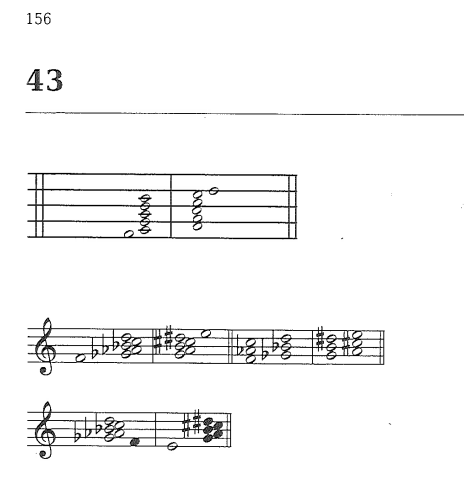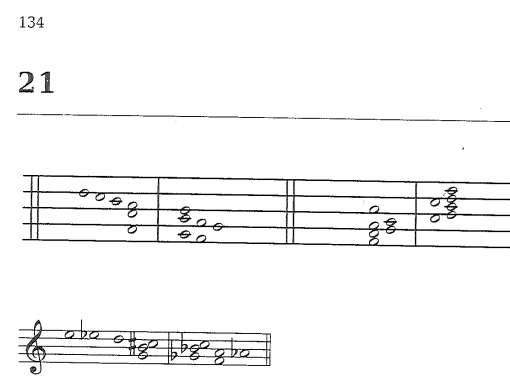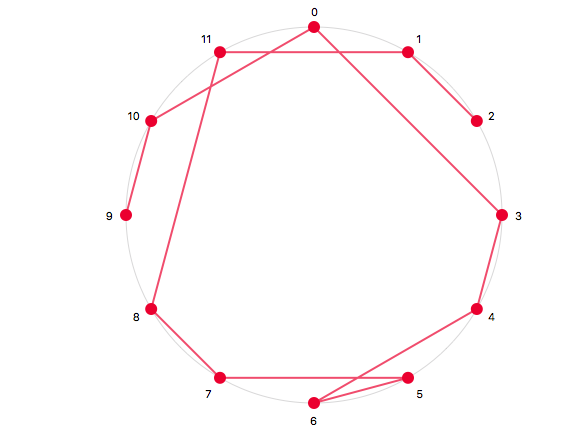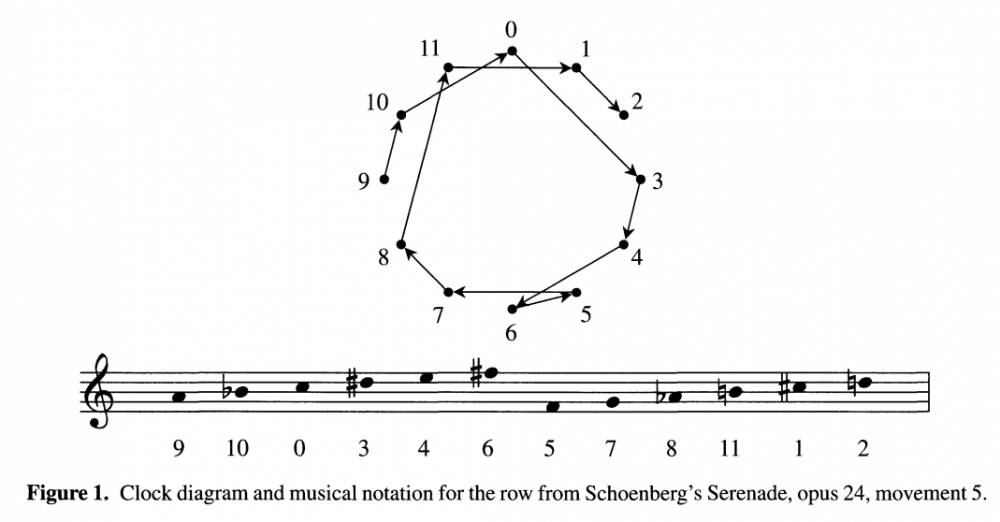-
Posts
839 -
Joined
-
Last visited
Content Type
Forums
Events
Store
Video Gallery
Everything posted by JulioHerrlein
-
Thanks a lot !! Best !
-
Dear All, I´m getting this result, using this function. Why ? It´s supposed to be 12/8... (omn-to-time-signature (length-augmentation 2 (pcs-rhythm '7-35 :rotate '(11) :omn t)) '(12 8))
-
Thanks, André ! Best ! Julio
-
Hello, Friends Is there some function to convert this: (1 0 0 1 0 1 1 0 1 0 1 0 0 0 0 1) 3 2 1 2 2 5 1 to this: (3 2 1 2 2 5 1) Best ! Julio
-
Great !
-

video A.S. Mailbox live performance !
JulioHerrlein replied to JulioHerrlein's topic in Made In Opusmodus
Thanks, Stephane and Janusz !! All the best ! Julio -
Dear Friends ! This is the performance of the piece A.S. Mailbox at the Musmat Congress ! This piece was all done in Opusmodus (with some post editing in Musescore). Happy to share this with you ! I have one more thing this week... There are many great pieces in the concert ! (and also a Schoenberg Quartet) ! Enjoy
-

audio Méditation for String quartet
JulioHerrlein replied to Stephane Boussuge's topic in Made In Opusmodus
Congratulations, Stephane !! Best ! -

Opusmodus on a Windows Machine (using VMWare)
JulioHerrlein replied to Wim Dijkgraaf's topic in Suggestions & Ideas
Sorry, but I´m not the owner of this video... But is already in this link: https://youtu.be/RzPEORQNlZI Best ! -

resolved Combination Function Result (is it rigth ?)
JulioHerrlein replied to JulioHerrlein's topic in Function Examples
Cool !!! Thanks a lot !!! Best ! -

resolved Combination Function Result (is it rigth ?)
JulioHerrlein replied to JulioHerrlein's topic in Function Examples
Thanks, Janusz Here is the breakdown of the equivalent permutations for the example 012 021 102 120 201 210 013 031 103 130 301 310 014 041 104 140 401 410 015 051 105 150 501 510 023 032 230 203 302 320 024 042 204 240 402 420 025 052 205 250 502 520 034 043 304 340 403 430 035 053 305 350 503 530 045 405 450 504 540 054 125 152 215 251 512 521 123 132 213 231 312 321 124 142 214 241 412 421 135 153 315 351 513 531 134 143 314 341 413 431 145 154 415 451 514 541 234 243 324 342 423 432 235 253 325 352 523 532 245 254 425 452 524 542 345 354 435 453 534 543 The first column is the unique "seed" that gives the other permutations Just the seeds 012 013 014 015 023 024 025 034 035 045 125 123 124 135 134 145 234 235 245 345 Seeds above, arranged as complementary sets 012,345 013,245 014,235 015,234 023,145 024,135 025,134 034,125 035,124 045,123 -

resolved Combination Function Result (is it rigth ?)
JulioHerrlein replied to JulioHerrlein's topic in Function Examples
According to the definition of the function: COMBINATION will return a list of all the combinations N elements in length from a list. There is something strange... For example: (combination 3 '(0 1 2)) gives ((0 1 2) (0 2 1) (1 0 2) (1 2 0) (2 0 1) (2 1 0)) and violate what the "unique combination" state you mentioned, since 0 1 2 is also (0 2 1) Looks like permutation... I´m looking for all n-permutations of a larger set, like 3 element permutations from a group of 6 elements (0 1 2 3 4 5). Maybe having the possibility of choosing the cardinality of permutations... Something like (permute 3 '(0 1 2 3 4 5)) should give the result I mentioned before (120 possbilities) Best, Julio -

resolved Combination Function Result (is it rigth ?)
JulioHerrlein posted a topic in Function Examples
Dear All, Recently, I used the function combination and got some strange result I did this (combination 3 '(0 1 2 3 4 5)) I got this result - 60 combinations (0 1 2) (0 1 3) (0 1 4) (0 1 5) (0 2 3) (0 2 4) (0 2 5) (0 3 4) (0 3 5) (0 4 5) (1 2 3) (1 2 4) (1 2 5) (1 3 4) (1 3 5) (1 4 5)(2 3 4) (2 3 5) (2 4 5) (3 4 5)(5 0 1) (5 0 2) (5 0 3) (5 0 4) (5 1 2) (5 1 3) (5 1 4) (5 2 3) (5 2 4) (5 3 4) ,(4 5 0) (4 5 1) (4 5 2) (4 5 3) (4 0 1) (4 0 2) (4 0 3) (4 1 2) (4 1 3) (4 2 3)(3 4 0) (3 4 1) (3 4 2) (3 5 0) (3 5 1) (3 5 2) (3 0 1) (3 0 2) (3 1 2) (2 3 0) (2 3 1) (2 4 0) (2 4 1) (2 5 0) (2 5 1) (2 0 1) (1 2 0) (1 3 0) (1 4 0) (1 5 0) There is something I did not get ? Best, Julio The expected result should be 6 x 5 x 4 = 120 Like this... 012 013 014 015 021 023 024 025 031 032 034 035 041 042 043 045 051 052 053 054 105 102 103 104 125 120 123 124 135 130 132 134 145 140 142 143 154 150 152 153 204 205 201 203 214 215 210 213 234 235 230 231 243 245 240 241 253 254 250 251 302 304 305 301 312 314 315 310 321 324 325 320 341 342 345 340 351 352 354 350 401 402 403 405 410 412 413 415 420 421 423 425 430 431 432 435 450 451 452 453 504 501 502 503 514 510 512 513 524 520 521 523 534 530 531 532 543 540 541 542 -
Cool !! Some live stream ? Best ! Julio
-

Editor Commands / customize shortcuts
JulioHerrlein replied to YiyangW's topic in Support & Troubleshooting
Midi Entry provides some interesting ways to do some shortcuts like opening parenthesis, entering rhythms (t s e q h w) , etc. -
Great, Janusz ! Thanks !
-
Best ! Julio
-
Acccording to the book (p. 156), there is a missing b4... Should be, like (pitch-transpose 5 (trope-hexachord 43)) ((f4 fs4gs4bb4c5d5) (g4a4b4cs5eb5 e5)) But there is a b4 missing
-
Another one ! Only 5 notes in TROPE 43 (second hexachord) (trope-hexachord 43) ((c4 cs4eb4f4g4a4) (d4e4gs4bb4 b4)) Yes, I´m researching Hauer now, for writing a paper ! Opusmodus is helping me a lot ! ! Best ! Julio
-
Dear All, The second half of trope 21 is showing a note repetition. (trope-hexachord 21) ((c4 b3 bb3 eb3g3a3) (d3fs3gs3 cs3f3 fs3)) The pitch-class fs3 appears twice, comprising a 5 note set (it should be an hexachord, a 6 note-set) (d3fs3gs3 cs3f3 fs3)) According to Sedivy (2011, pg 134) the trope 21 is shown below: In Sedivy´s book, this trope are shown starting in E, thus (pitch-transpose -8 (trope-hexachord 21)), thus ((e3 eb3 d3 g2b2cs3) (fs2bb2c3 f2a2 bb2)) There is a repetition of two Bb pitch classes in the second hexachord (pitch-transpose -8 (melodize (last (trope-hexachord 21)))) ((fs2 bb2 c3 f2 a2 bb2)) According to the book, the last note should be an Ab, not a Bb, like ((e3 eb3 d3 g2b2cs3) (fs2bb2c3 f2a2 ab2)) All the best ! Julio
-

audio Function studies (Improviation No.1)
JulioHerrlein replied to opmo's topic in Made In Opusmodus
Nice improvisational effect ! Best ! -

resolved Ploting Graphs for 12 tone properties
JulioHerrlein replied to JulioHerrlein's topic in Score and Notation
(circle-pitch-plot '(9 10 0 3 4 6 5 7 8 11 1 2) :sort nil :remove-duplicates t :join-first nil :point-radius 6) -
Dear All, I´m looking for a way to plot some graphs like these, showing 12 tone row ordering: I think that a function like this would be easy to program and adapt from the library. I don´t if there exist already something similar... It´s useful to show properties of 12 tone sets, like Tropes, simmetry relations, geometric operations. Best ! Julio How Rare Is Symmetry in Musical 12-Tone Rows? on JSTOR WWW.JSTOR.ORG David J. Hunter, Paul T. von Hippel, How Rare Is Symmetry in Musical 12-Tone Rows?, The American Mathematical Monthly, Vol. 110, No. 2 (Feb., 2003), pp. 124-132 HERE !!! FOUND !! (circle-pitch-plot '(0 2 6 0 3 7 0 4 8) :sort nil :point-radius 6)







